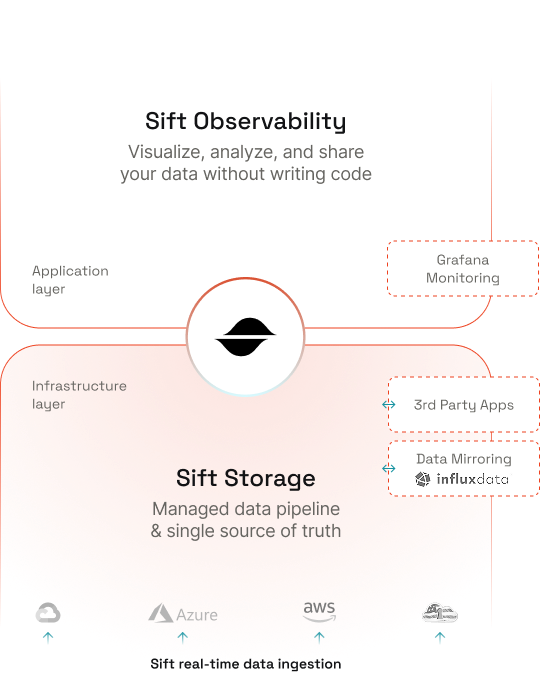Sift Observability
Centralized, code-free insights at your fingertips
Visualize data and pinpoint root causes
Request a Demo
Visualization, review, and reporting in one unified platform
With Sift Observability, you can explore and analyze high-cardinality data in a centralized view, without writing any code. Continuous, automated reviews help you detect anomalies in real-time while reducing the risks associated with manual data reviews. Secure role-based access simplifies reporting and collaboration across teams.
Old Way
The “check engine” light is on, but you’re left guessing, juggling fragmented tools and dashboards without clear answers.

Sift Observability
Analyze high-cardinality data, detect anomalies in real-time, and share insights easily — no code required. Get answers fast, no more guessing.

Analyze data from multiple data sets without taking the time to write a single line of code — no Python scripts or SQL queries needed. Unify all your data sources in a single view for comprehensive insight.
.png)
Sift offers a centralized platform for sharing and annotating data, capturing institutional knowledge. With unified views, customizable rules, and in-line annotations, Sift makes insights accessible, creating a growing, searchable source of truth.
.png)
Sift allows you to create multichannel “derived” telemetry. If you’re already tracking mass and acceleration, simply derive force. Use conditional logic and mathematical expressions to build complex telemetry channels, providing a complete picture of your hardware’s performance.

Sift’s automated review saves time by eliminating the need for scripts or SQL queries. The integrated “Rules” feature ensures continuous validation, delivering thorough and reliable data reviews, with Role-Based Access Controls (RBAC) safeguarding sensitive data.

Real-time anomaly detection with customizable alerts helps your team efficiently identify and root cause issues, minimizing noise. Sift’s evolving set of rules also uncovers unknown edge cases, ensuring that only critical failures are flagged.

Sift’s user-friendly bulk editing allows even non-coders to configure rules across datasets. You can reconcile logs with time-series data, compare telemetry with historical events, and correlate failures, enabling rapid troubleshooting.

Sift enables one-click report generation, turning data reviews into certification reports effortlessly. Customize reports to meet regulatory compliance with all necessary details.
.png)
Easily manage and communicate thousands of continuously updated checks with Sift. Define plots, comment on annotations, and track rule history for full traceability and integrity.
.png)
Simplify the management of test campaigns and flight data with Sift’s tools. Tag, sort, and organize telemetry and annotations with customized filters and dashboards tailored to specific scenarios.
